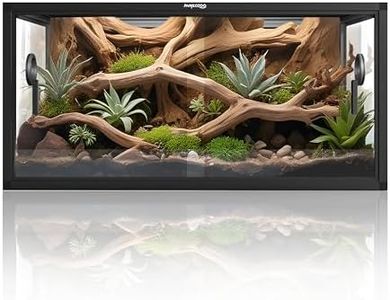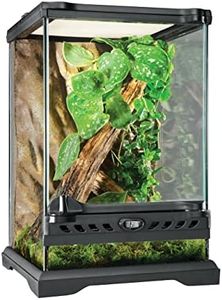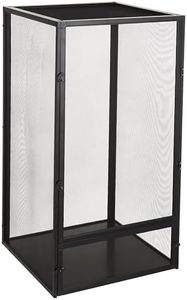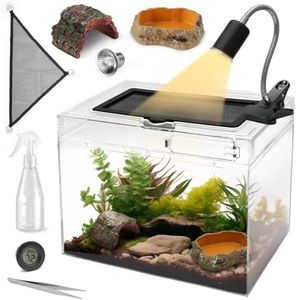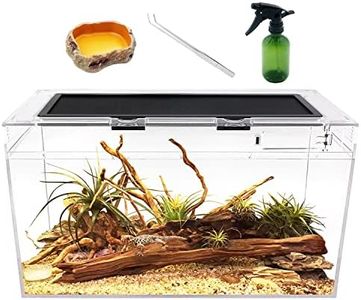We Use CookiesWe use cookies to enhance the security, performance,
functionality and for analytical and promotional activities. By continuing to browse this site you
are agreeing to our privacy policy
5 Best Bearded Dragon Enclosure
From leading brands and best sellers available on the web.Buying Guide for the Best Bearded Dragon Enclosure
Choosing the right enclosure for your bearded dragon is important because it directly affects their health, happiness, and ability to thrive. The enclosure is not just a cage—it’s your pet’s home, providing space to move, places to hide, and the right environment for heating and lighting. When shopping for a bearded dragon enclosure, you’ll want to focus on the size, material, ventilation, ease of cleaning, and compatibility with accessories like lighting and décor. Your goal is to match your enclosure to the adult size and needs of your bearded dragon, keeping their safety and comfort as your top priority.SizeSize refers to the measurements of the enclosure—length, width, and height. It's crucial because bearded dragons need space to move, bask, climb, and explore, especially as they grow. For young dragons, smaller enclosures are sometimes used, but adults generally need more space, with typical segments being small (20-40 gallons), medium (40-75 gallons), and large (over 75 gallons or at least 4 feet long). The right size for you depends on your dragon’s age and eventual adult size—always plan for the adult, as they quickly outgrow smaller habitats. A larger enclosure allows for better heat gradients and enrichment, promoting healthier and happier pets.
MaterialMaterial describes what the enclosure is made from, such as glass, wood, plastic, or metal. This is important for insulation, visibility, durability, and ease of cleaning. Glass enclosures give clear views and are easy to sanitize but may lose heat faster. Wooden or melamine enclosures hold in heat but may be harder to clean thoroughly. Plastic options can be lightweight and maintain warmth well. For those in cooler climates, materials that hold heat are helpful, while in warmer homes, ventilation becomes more important. Consider your room temperature, how easy you want cleaning to be, and the look you prefer when picking material.
VentilationVentilation determines how air moves in and out of the enclosure, affecting humidity, air freshness, and temperature stability. Good ventilation prevents mold, stale air, and overheating. Some enclosures have mesh tops or side vents, while others have limited airflow. Mesh provides excellent air exchange but can make it harder to maintain humidity. Solid tops or sides keep warmth in but may restrict fresh air. If your home is dry, you may want less ventilation, but in humid places or if using high-wattage lamps, more airflow is a must. Match ventilation to your climate and setup, aiming for balance.
Ease of CleaningEase of cleaning refers to how simple it is to maintain hygiene in the enclosure. This is essential because bearded dragons can become ill if their area isn’t kept clean. Features like removable lids, large doors, and smooth surfaces make cleaning less of a hassle. Some enclosures have fixed tops or tight corners that are tough to reach. If you want to spend less time on maintenance, look for spacious access points and materials that don’t stain or absorb odors. Consider your routine and how often you want to deep clean when making your choice.
Lighting & Heating CompatibilityLighting and heating compatibility means how readily the enclosure can accommodate the bulbs, heat lamps, and fixtures your bearded dragon needs. Bearded dragons require UVB for health and basking lights for proper temperature. Some enclosures come with built-in fixtures or spaces to mount them; others need you to attach lamps over a mesh screen or through light holes. Make sure the design lets you place lights at safe distances without gaps where your pet could escape. Choose an enclosure that makes it easy to set up and adjust both UV and heat lighting based on your pet's needs and your preferred maintenance style.
SecuritySecurity refers to how well the enclosure keeps your dragon inside and unwanted guests out. This matters for your pet’s safety and for peace of mind. Factors include the type of locks, door latches, and how tightly fittings come together. Snap-on lids or sliding doors can be convenient but should be escape-proof, especially with curious pets or other animals in the home. Select an enclosure that provides strong, reliable closure mechanisms suitable for your environment and your handling routine.
